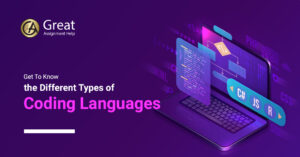Computers understand different languages. There are several types of coding languages, including procedural languages like C, object-oriented languages like Java, and scripting languages like Python. Each type serves a specific purpose, from web development to mobile app development. Generally, knowing these languages will help programmers select the most suitable one for their project.
In recent times, programming languages have been extensively used for developing several web and mobile applications. Hence, programming is considered the hottest topic amongst the techies in the IT industry. Moreover, in the software field, those who have strong knowledge of any coding language have more job opportunities with high salary packages. Basically, there are numerous types of coding languages available. Do you have any idea about the different types of coding languages? In case you are unaware, then check this blog post. Here, we have presented complete information about what a programming language is and the different types of programming languages.
What is a Coding Language?
Coding, on the whole, is the process of giving instructions to a computer, while code is what a machine is supposed to do. When you give a computer a set of instructions, first it will understand them and then it will react appropriately to an event. You can use code to tell the computer what to do and how to behave, but you need to know how to write code to do that. Most of the time, you can make apps and websites, process data, and do a lot of other things with strong coding skills.

Real-time Use of Coding Languages
Coding is basically involved in everything that has to do with technology in some way. Specifically, interactive applications for computers, phones, tablets, smart TVs, and calculators can be created using coding languages. In addition, programming languages are also used to build advanced digital systems and modern vehicles with multiple functions.
Recently, coding is widely used to control everything from fuel injectors to air conditioning in automobiles. Moreover, advanced coding languages are also utilized in the development of software programs, technology-based applications, artificial intelligence, and machine learning. Other popular digital applications that use different types of coding languages are medical records systems, attendance systems, social media websites, e-polling, etc.
Also Read: Know Interesting Facts about the C Language
What are the Types of Coding Languages?
The coding languages are classified into 3 different types, namely
- Machine Language
- Assembly Language
- High-Level Language
Machine Language
A machine language, also called machine code or object code, is a language that is understandable to computers. It is the first-generation coding language. The machine code is usually made up of binary numbers 0 and 1, and hence it is easy for the computer systems to read and execute them. Typically, machine language is the native language of computers. Therefore, the code is executed by the Central Processing Unit (CPU). Mainly, to determine the machine language used for that computer system, the computer’s Operating System (OS) is used.
In general, it is tough for humans to understand machine language because it represents all the commands in the binary format, either 0 or 1. Basically, a computer’s OS specifies how to write programs for the computer, so that they can execute on the machine without any difficulties.
Assembly Language
Assembly language or assembly code is a low-level language that is primarily used for programmable devices and microprocessors. It is the second-generation coding language mainly used to program CPU architecture. This language is popular for its use in developing operating systems and desktop applications. Some significant tasks performed by assembly programming languages are memory management, registry access, and clock cycle operations.
The assembly code does not provide code reusability and is also difficult to understand. The operations performed with assembly language can be executed on a CPU only after the assembly code is converted to machine code by the assembler. In general, the assembly language has structure and directives similar to machine language. However, instead of numbers, it uses names. This language is suitable for all high-speed operations when compared to high-level languages. The disadvantage of assembly language is that it doesn’t have variables and functions, and it cannot run on other systems.
High-Level Language
High-level programming languages have strong abstraction. Also, it has a syntax that is easy to read, write, and understand. Another advantage is that the code doesn’t depend on a computer system. Mostly, this language primarily focuses on programming rather than the components of computer hardware, such as memory utilization or the registry. In particular, high-level languages allow a programmer to create a human-readable program that is easy for all users to understand.
As it is tough for the computer system to understand the program written in a high-level language, it requires a compiler or interpreter. Some popular high-level languages are C, C++, Java, Ruby, FORTRAN, Perl, and Visual Basic.
Different Types of Coding Paradigms
The coding paradigm is one of the important factors beyond high-level and low-level programming languages. It is nothing but the styles of programming. Listed below are some different types of coding language paradigms.
- Database Programming
- Object-oriented Programming
- Functional Programming
- Logical Programming
- Procedural Programming
List of Coding Language Types Based on Their Usability
In our world, there are various types of programming languages used for specific purposes. Hence, according to usability, we can group the coding languages as front-end coding languages and back-end coding languages. Now, let us have a closer look at both the front-end and back-end web development coding languages.
Front-End Web Development Coding Languages
The front-end developer creates the user side of applications, i.e., the developer will code games, software, apps, or webpages that human beings can view. For instance, the webpage that you are viewing right now is developed by a front-end web developer using a specific coding language. Some common front-end coding languages include
- HTML
- CSS
- JavaScript
HTML
HTML (Hyper Text Markup Language) is a language that is used for creating web pages. Mainly, this language contains a series of elements and attributes, and also describes the structure of a webpage. Specifically, the HTML elements inform the browser on how to display the content to the end users.
CSS
CSS (Cascading Style Sheets) is a language that is primarily used to style a webpage. Basically, this language describes how to display the HTML elements on paper, screens, or any other media. With the help of CSS, the layout of multiple web pages can be controlled at once. Generally, CSS takes text-based websites and applies images, videos, colors, and other types of media to them. The main purpose of this language is to create a website that is appealing to the target viewers.
JavaScript
JavaScript is a client-side scripting language that all web browsers support. It is an open-source programming language that is predominantly used to improve the users’ interaction with the webpage. This language is also known as the programming language of the web. Also, with the help of JavaScript programming, games and mobile applications can be developed.
Back-End Web Development Coding Languages
As the name suggests, the back-end web developer controls everything that happens behind the backside of your website. Commonly, it is called programming on the service. Some famous back-end coding languages are
- Java
- Python
- Ruby
Java
Java is a high-level coding language that is widely used for the creation of desktop applications, web servers, Android mobile applications, games, application servers, big data analysis, and so on. Basically, Java is a general-purpose class-based, object-oriented, network-centric programming language that is fast and reliable. Hence, it is widely used for development purposes. Mainly, this programming language is designed to have fewer implementation dependencies.
Also, Read – Top 109 Java Project Ideas for Beginners and Experts
Python
Python is a famous programming language that is mainly used for the development of web applications, software, rapid prototyping, and system scripting. This language can be used on a server to develop web applications. Also, it can be used alongside software to create workflows. In addition to that, the language can also be utilized to handle databases, analyze big data, and perform complex mathematical operations.
Read More – Top Python Interview Questions For Beginners and Experienced
Ruby
Ruby is an interpreted, general-purpose, high-level programming language that supports multiple programming paradigms. It is a flexible, object-oriented coding language. Similar to Python, Ruby is a server-side scripting language. This language can be used to compose Common Gateway Interface (CGI) Scripts, and it can also be embedded into HTML. Also, the coding language has a rich set of built-in functions that can be used in Ruby Scripts. It supports many GUI tools such as OpenGL, GTK, and Tcl/Tk, and can be utilized for creating internet and intranet applications.
Conclusion
We hope you are now clear about the different types of coding languages available. In case you wish to know more about any of these coding languages, or if you are struggling to write your coding assignments in any programming language, such as C, C++, Java, Python, etc., immediately reach out to us. The programming assignment help experts on our team with strong coding skills will guide you in developing error-free projects using any language of your choice. Especially with the assistance of our coding specialists, you can also enhance your knowledge of programming languages and work on any real-time application.



